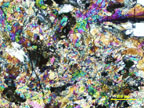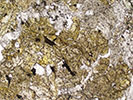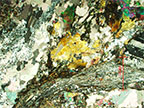|
Epidote
|
|
Property
|
Value
|
Comments
|
| Formula |
Ca2(Al,Fe)Al2O(SiO4)(Si2O7)(OH) |
Complete solid solution from clinozoisite (Al: Fe 3+ = 3:0) to epidote (Al:Fe 3+ = 2:1) |
| Crystal System |
monoclinic |
|
| Crystal Habit |
coarse to fine granular ; also fibrous |
Found in aggregates of elongate prismatic crystals with pseudohexagonal cross sections |
| Cleavage |
{001} perfect, {100} imperfect |
perfect cleavage in one direction |
| Luster |
Vitreous, some resinous. |
|
| Color/Pleochroism |
clinozoisite: pale green to gray. Pleochroism can be strong in transparent
forms, appearing green and brown at different
angles.
|
epidote: pistachio-green to yellowish-green to black |
| Optic Sign |
clinozoisite: Biaxial ( +) |
epidote: Biaxial ( -)
|
| 2V |
clinozoisite: 2V= 14-19 degrees |
epidote: 2V = 64-90 degrees
|
| Optic Orientation |
Y=b
O.A.P. = (010) |
Varies strongly with composition. |
Refractive Indices
alpha =
beta =
gamma =
|
clinozoisite
1.670-1.1.715
1.674-1.725
1.690-1.734
|
epidote
1.715-1.751
1.725-1.784
1.734-1.797
|
| Max Birefringence |
=0.004 - 0.049 |
Refractive indices and birefringence increase with iron content. |
| Elongation |
Elongate crystals may be either length fast or length slow, since Y is parallel to length. |
Zoned crystals may show adjacent zones with different sign of elongation. |
| Extinction |
Parallel to length of elongate crystals and to the trace of cleavage. |
Oblique to cleavage in pseudo-hexagonal sections, otherwise straight on cleavage in prismatic section |
| Dispersion |
Optic axis dispersion is usually strong with v > r (clinozoisite) or r > v (epidote.) |
|
| Distinguishing Features |
Epidote is characterized by its green color and one perfect cleavage. H= 6-7. G = 3.25 to 4.45. Streak is white to gray. Clinozoisite and epidote are distinguised from eachother by optic sign, birefringence, and color. |
| Occurrence |
Occurs in areas of regional metamorphism; forms during retrograde metamorphism and forms as a reaction product of plagioclase, pyroxene, and amphibole. Common in metamorphosed limestones with calcium rich garnets, diopside, vesuvianite, and calcite. |
| Sources |
Nesse, William D: Introduction to Optical Mineralogy (Oxford University Press, 1986) pp.192-193 |
| Editors |
Sarah Hale ('07), Shawn Moore ('13), Tessa Brown ('17) |


